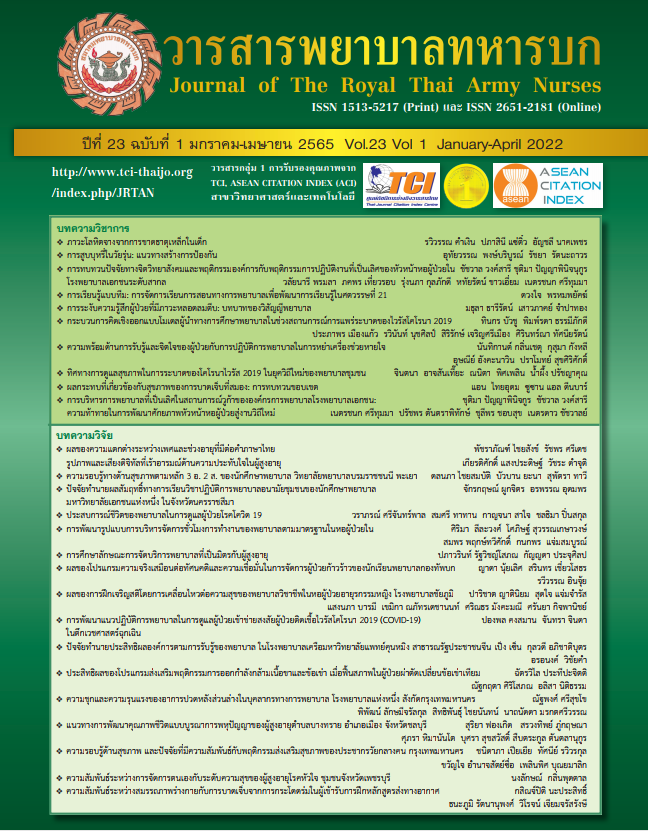Model Development of Nursing Manpower Management in Inpatient Department
Keywords:
model development, nursing manpower managementAbstract
The objective of this research and development was to develop a model of nursing manpower management in Inpatient department. The research involved 7 research participants from the nurse administrators and 50 randomly nurses. It was implemented Mahdjoubi (2009) as a research methodology. Quantitative and qualitative data were collected using mixed methods. The instruments used consisted of two parts 1) the research instrument which were manual of nurse’s working hour management and scheduling program 2) the data collection instruments comprising survey form and discussion guidelines, the model results recording form, and the questionnaire as well as the evaluation form of the model which Cronbach’s alpha coefficient were 0.93 and 0.76. All instruments were checked for content validity. The data were analyzed by using descriptive statistics and content analysis.
The results showed that the model consisted of policy, nurse’s working hours management manual and scheduling program. Managing consisted of 4 strategies: Standard Nurses’ Working Hours Management, Nursing task review, Nursing skills mix, and Clinical supervision. The results after model implementation showed that the nurses’ opinion to the model were at a high level. Most of the patient safety indicators and nurse working hours improved in all wards. Average of nurse’s working hours reduced from 66.8 to 52.5 hours per week.
Downloads
References
Sawaengde, K. Crisis of Nursing shortage in Health Service Facilities under Office of Permanent Secretary, Ministry of Public Health: Policy Recommendation. Journal of Health Science; 2017, 26(2): 456-468. (in Thai)
Srisuphan, W., Sawaengde, K. Policy Proposal for Solving the Shortage of Register Nurse in Thailand. Thai Journal of Nursing Council; 2012. 27(1): 5-12. (in Thai)
Kru-on, K., Oumtanee, A. Nurse Staffing in a Medical-Surgical Unit, a Private Hospital. Journal of The Royal Thai Army Nurses; 2018. 19 (supplement): 262-268. (in Thai)
Nantsupawa, R., Wichaikhum, O., Nantsupawat, A. The Relationship between Nurses’ Extended Work Hours and Patient, Nurse and Organizational Outcomes in General Hospital. Nursing Journal; 2014. 41(4): 58-69. (in Thai)
Roger, A., In Hughes R. The effects of fatigue and sleepiness on nurse performance and Patient Safety. In Patient Safety and Quality: An Evidence-based Handbook for Nurses. Rockville: Agency for Healthcare Research and Quality.2018
Scott L., Rogers A., Hwang W., Zhang Y. Effect of critical care nurses’ work hours on vigilance and patients’ safety. American Journal of Critical Care; 2006. 13 (1): 30-7.
The Healthcare Accreditation Institute. Thailand’s patient safety goals. Documents for the SIMPLE meeting. 2018. (in Thai)
Office of Permanent Secretary, Ministry of Public Health. Documents supporting the meeting to determine the appropriate time of medical personnel. Working group to determine the appropriate working hour of medical personnel. November 26, 2018. Ministry of Public Health, Nonthaburi Thailand. (in Thai)
Nursing Council. Nurse working hours policy for patient safety. Announced on 17 April 2017. (in Thai)
Nursing Division, Ministry of Public Health. Guidelines for collecting indicators for improving the quality of nursing service Fiscal Year 2022. 2021. Nonthaburi: Nursing Division.
Sathira-angkura, T., Jamsomboon K., Wongsuvansiri, S. Situation of Nursing Working Hour in Thailand. Journal of Nursing Division; 2019. 46(2): 242-256. (in Thai)
Backhaus, R. et al; Nurse Staffing Impact on Quality of Care in Nursing Homes: A Systematic Review of Longitudinal Studies. J. Am. Med. Dir. Assoc, 2014. 15(6), 383–393.
Nursing Council. Nursing and Midwifery Profession Act B.E.2528. Amended by the Act Nursing and Midwifery Practice (No.2), B.E. 2540. Government Gazette, Decree Edition, Volume 114, Part 75 Kor, 23 December 1997.
Praphanwattana, M. Medical management requires high caution. In: Praphanwattana, M. (Ed.). (2010). Medicine system for safety. BKK: the Foundation of Printing; 2019. 259-286.
Office of Nursing, Department of Medical Service, Ministry of Public Health. Nursing Standards in Hospitals (2nded.). Bangkok: Veterans Organization Printing House. 2008
Sathira-angkura, T. et al. Development of Nursing Manpower Management Model for Patient Safety: a Pilot Study in Ratchaburi Province. Journal of Health Science, 2019. 28(6): 1130-1142. (in Thai)
Rosner, B. Fundamentals of Biostatistics. 5th ed. Pacific Grove, CA Duxbury. Sirichai K. Research and development for Thai education. Silpakorn Educational Research Journal; 2000. 8(2): 1-18. (In Thai)
Kanjanawasee, S. (2016). Research and development for Thai education. Silpakorn Educational Research Journal; 8(2): 1-18. (In Thai)
Spetz, J. Nurse satisfaction and the implementation of minimum nurse staffing regulations. Policy Polit Nurs Pract; 2008. 9(1): 15-21.
Songkarak, S. The Effects of Clinical Supervision Program for First Level Nursing Manager at a Tertiary Level Hospital in Phetchaburi Province. Thesis in Master Nursing Program Nursing Administration, Faculty of Nursing, Christian University. 2017. (in Thai)
Pritchaya Kon, R. Attitude of Using Job Rotation System: The Study in Officer Administration of Department, Faculty of Medicine, Prince of Sonkhla University. Journal of Humanities and Social Sciences; 2013. 9(2): 41-56. (in Thai)
Downloads
Published
How to Cite
Issue
Section
License
Copyright (c) 2022 Journal of The Royal Thai Army Nurses

This work is licensed under a Creative Commons Attribution-NonCommercial 4.0 International License.
บทความหรือข้อคิดเห็นใดใดที่ปรากฏในวารสารพยาบาลทหารบกเป็นวรรณกรรมของผู้เขียน ซึ่งบรรณาธิการหรือสมาคมพยาบาลทหารบก ไม่จำเป็นต้องเห็นด้วย
บทความที่ได้รับการตีพิมพ์เป็นลิขสิทธิ์ของวารสารพยาบาลทหารบก
The ideas and opinions expressed in the Journal of The Royal Thai Army Nurses are those of the authors and not necessarily those
of the editor or Royal Thai Army Nurses Association.






